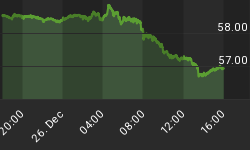On November 21, 2007 the primary trend, in accordance to classical Dow theory, was confirmed as bearish. To date, nothing has occurred to invalidate that setup. According to Dow theory, once the primary trend is established, that trend must be considered intact until it is "authoritatively" reversed, which in this case would require a joint move by the averages back above their previous secondary high points. Since that has yet to occur, the primary trend must still be considered bearish.
Now I want to turn to the chart of the Industrials and the Transports below and in doing so I want to walk through a few things. First, I have marked the non-confirmation that occurred at the 2007 top in red. It was then from that non-confirmation that the averages ultimately drifted lower and then on November 21, 2007 with the joint move below the August 2007 secondary low points, marked in pink, that the primary bearish trend was established. The Transports then made their next secondary low point in January 2008 while the Industrials did not make their next secondary low point until March 2008 and I have marked this non-confirmation in black. It was then from this non-confirmation that the 2008 rally into the May/June highs began.

At these highs the Transports moved above their 2007 highs while the Industrials lagged and in doing so created another upside non-confirmation, which I have marked in blue. It was then from this upside non-confirmation that the 2008 meltdown got into gear and the last joint low made by both averages occurred on November 20, 2008. From that low the averages again rallied into the most recent minor highs that were made in early January. It was then from these minor highs that the Transports moved below their November closing low. But, because the Industrials did not, another non-confirmation has been born. I have heard that some are saying that this downside non-confirmation is bullish. It is true that non-confirmations often occur at the end of a move and can in some cases signal at least a temporary trend change. This should be obvious from the examples seen just in the chart above. However, just as the January/March 2008 non-confirmation was only lead to a temporary reversal, it's a bit too early to break out the party hats just yet. Rather, in the current case, I see this non-confirmation as an indecisive period that requires further confirmation.
For this I want to share a few quotes with you from our Dow theory founding fathers on this subject.
William Peter Hamilton - "The movement of both the railroad and industrial stock averages should always be considered together. The movement of one price average must be confirmed by the other before reliable inferences may be drawn. Conclusions based upon the movement of one average, unconfirmed by the other, are almost certain to prove misleading."
William Peter Hamilton - "Dow's theory stipulates for a confirmation of one average by the other. This constantly occurs at the inception of a primary movement, but is anything but consistently present when the market turns for a secondary swing."
William Peter Hamilton - "When one breaks through an old low level without the other, or when one establishes a new high for the short swing, unsupported, the inference is almost invariably deceptive."
William Peter Hamilton - "Indeed it may be said that a new high or a new low by one of the averages unconfirmed by the other has been invariably deceptive. New high or low points for both have preceded every major movement since the averages were established."
William Peter Hamilton - "The two averages may vary in strength, but they will not vary materially in direction especially in a major movement. Throughout all the years in which both averages have been kept, this rule has proved entirely dependable. It is not only true in the major swings of the market, but it is approximately true of the secondary actions and rallies. It would not be true of the daily fluctuations, and it might be utterly misleading so far as individual stocks are concerned."
Robert Rhea - "The most useful part of the Dow theory, and the part that must never be forgotten for even a day, is the fact that no price movement is worthy of consideration unless the movement is confirmed by both averages."
Robert Rhea - "The Dow theory deals exclusively with the movement of the railroad and industrial stock averages, and any other method would not be Dow's theory as expounded by Hamilton."
Robert Rhea - "A wise man lets the market alone when the averages disagree."
Robert Rhea - "When the averages disagree they are shouting 'be careful.'"
So, my point here is that this while this downside non-confirmation may be construed to have at least temporary positive implications, nothing has occurred within the context of Dow theory to invalidate the existing bearish primary trend. Also, it should be clear from the quotes above, non-confirmations represent periods of uncertainty and further confirmation of either a reversal are required and in the meantime, the existing bearish primary trend must still be consider to be in force until it is authoritatively reversed.
I have begun doing free Friday market commentary that is available at www.cyclesman.com/Articles.htm so please begin joining me there. The February issue of Cycles News & Views has been released and in it I give detailed analysis of the current situation from both a cyclical and a Dow theory perspective as well as a look at the currently applicable statistics. I also have a very detailed slide show presentation on cycle quantifications and the Big Picture. A subscription includes access to the monthly issues of Cycles News & Views, which included Dow theory, a very detailed statistical based analysis covering not only the stock market, but the dollar, bonds, gold, silver, oil and gasoline along with short-term updates 3 times a week.
















